Fenix Rage Review
It’s always a little bit worrying when self-awareness finally pushes through in this industry. Demon’s Souls and Dark Souls earned a reputation for being harrowingly difficult – rightfully so, but focussing on that above all else is a bit like going to the cinema and remarking exclusively on the size of the screen – and before you knew it every last piece of Dark Souls II promotional material was specifically designed to push that one quality in our faces above all others. Improved combat mechanics? More stable multiplayer? “Sod that, let’s keep telling them how much they’re going to die. Maybe if we keep it up they’ll start to believe it.” And who could forget the trend of masochistic ultra-hard platformers? Engorged by the blood of a thousand badly-recorded Let’s Plays of I Wanna Be The Guy, their reputation for being frustrating beyond words is well-deserved. Naturally there was going to be a game sooner or later that took advantage of that, and Fenix Rage embodies that profile. Look, it’s even right there in the title. “Hey guys, our game will make you rage. Look at how rage-inducing it is. Are you enraged yet? Oh god, please point a webcam at yourself and shout angrily at our game; it’s the only marketing we’ll ever get.”
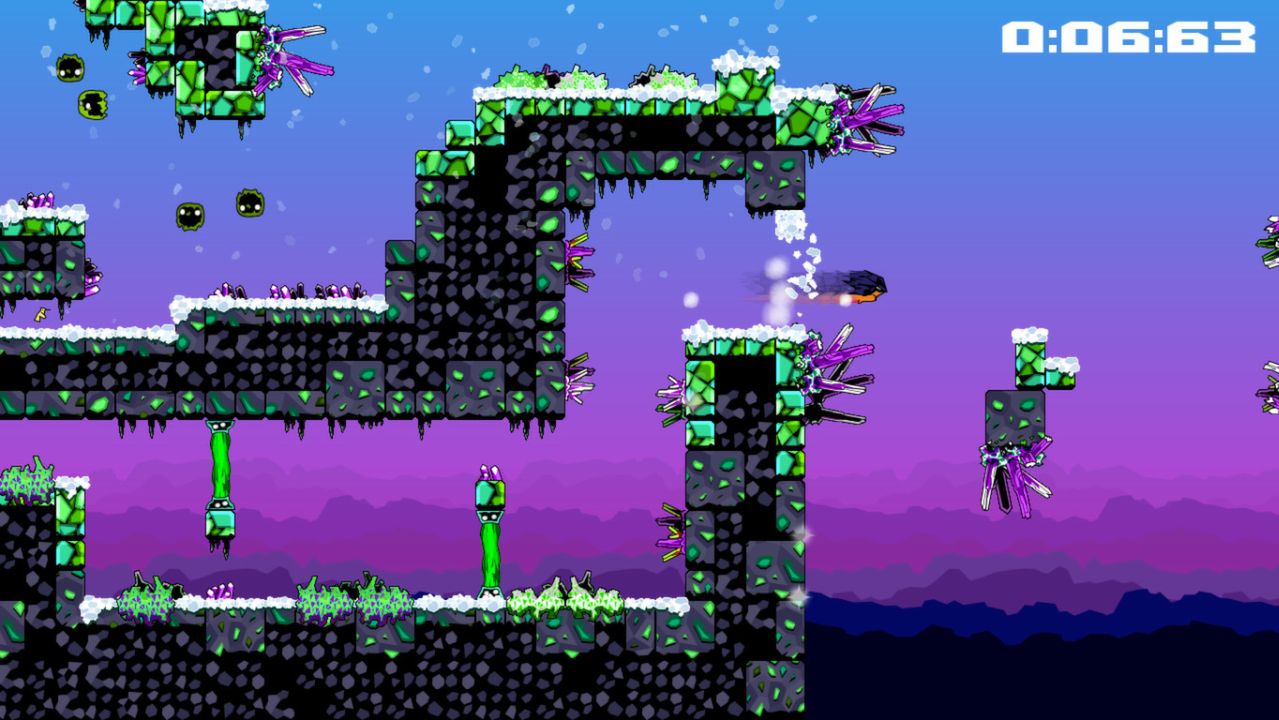
Alright, that was uncalled for. To be fair, Fenix Rage more or less lives up to the movement it seeks to hijack, which is odd because it gives you an unprecedented level of control that would, were you to transplant it into any other platformer you care to name, make it insultingly easy. Fenix, the main character – who looks for all the world like a permanently angry tangerine wearing a Mario Kart blue shell for a helmet – can jump and horizontally dash indefinitely in mid-air. There’s no catch here: no matter what position, location or state you’re in, you can always jump and dash. Any platformer in which touching the platforms is entirely optional may not sound like a challenge, but Fenix Rage is the kind of game where – thanks to its arrangements of lethal obstacles – you won’t want to touch the platforms. Or the ground, for that matter. If I’m honest, you really don’t want to touch anything. I’m not even sure we can call it a platformer at this point; it’s more like an aerial manoeuvring side-scroller.
Furthermore – not that I want to imply anything by this, no sir – Fenix Rage is going to seem awfully familiar to anybody who has ever played a certain famous meat-themed platformer. Of course, there’s always going to be a bit of overlap between masochistic platformers when their niche is narrow enough to lose spare change in, but when you have short themed levels full of carefully-timed moving instant-death obstacles, hard-to-reach collectibles and wormholes to bonus levels that disappear after a short amount of time, it’s hard not to picture Green Lava Studios turning up to Team Meat’s headquarters with an insulated panel van, some balaclavas and two hessian sacks. Not that that’s a problem in itself – well, assuming you aren’t a member of Team Meat, in which case I’d wager you’d deem it a massive problem – but somebody needs to draw attention to it. Not being a problem doesn’t mean we aren’t going to point and laugh.
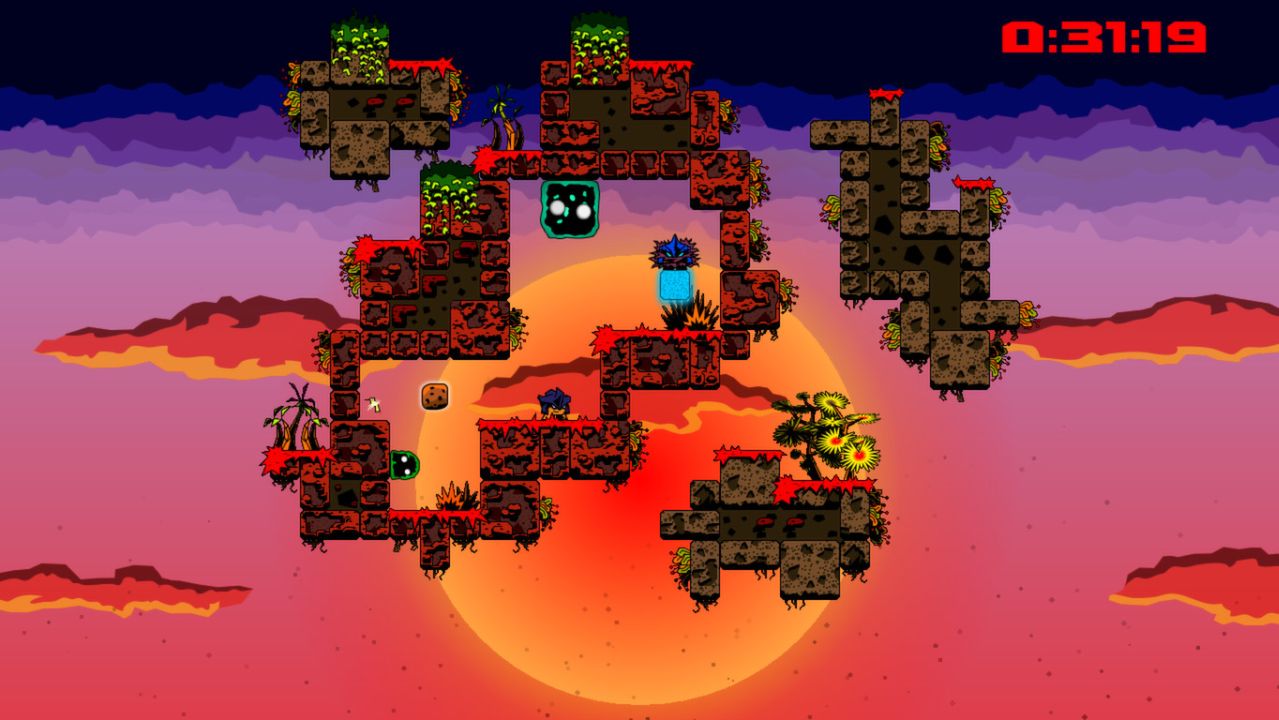
As a matter of fact, Fenix Rage almost feels like the opposite side of the same coin from Super Meat Boy. While both are structurally similar, their actual platforming mechanics are almost diametrically opposed: the latter being all about momentum, graceful arcs and slick slides; the former being all about whiplash directional changes and frantic weaving. What they thankfully share is controls so tight you could use them to perform open heart surgery on a dehydrated gnat. Everything you perform in Fenix Rage has this wonderful sense of responsiveness and instantaneousness to it: no wasted frames, just dash dash jump dash jump jump dash jump jump jump dash, repeating ad infinitum, or at least until your fingertips are flattened into hideous red-raw stubs. Even with just those two simple actions, the controls have their own little subtleties to them: you can cancel out of a dash with a jump, or a jump with a dash, and when you’re surrounded by deadly green lasers with less room to move than a Transperth bus seat, that might be the exact detail that lets you slip through. Ultimately your biggest weakness is not an inability to gain enough height, but an inability to lose it; sometimes gravity just isn’t fast enough.
Look, I know it sounds like I’m concerning myself with tiny, unnecessary details here, but you tend to become acutely aware of nuances like that when you come up against Fenix Rage’s level design: a seemingly endless stream of deviously-arranged obstacles that are guaranteed to make you… well, moderately annoyed, at the very least. It’s textbook stuff, this. Each world introduces at least one or two new elements, then proceeds to systematically utilise them in a number of surprisingly imaginative contexts. If you were worried that this was going to be one of those games that just throws you in a box with a squintillion spikes and sits back, never fear: there’s no such nonsense here. Well, maybe one or two levels fall into that category. Wait, I just found a third one. For the most part, though, enough variety has been injected into Fenix Rage to make every new level a little burst of joy. It’s not quite the overwhelming frustration generator that it claims to be – at least, not if you’re just playing on humdrum Normal difficulty – but it’s challenging enough to make completing a level feel like an achievement in its own right, rather than just a sliver of progression.
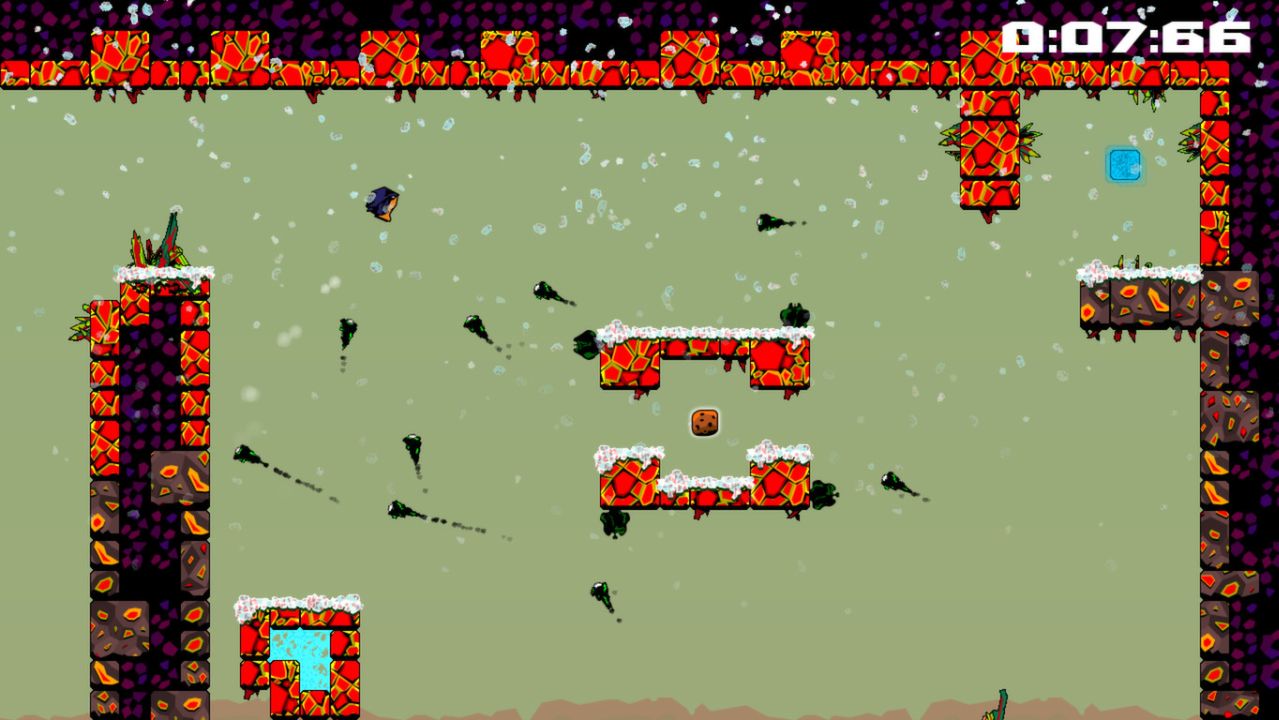
If you are the sort who spends time on internet forums critiquing I Wanna Be The Pointless Derivative Fan-game #0451 and carefully plotting out speedrun routes for your favourite obscure NES platformer that nobody else has ever heard of, worry not: when it comes to additional challenges Fenix Rage really goes the extra mile, to an almost concerning degree. Finishing the game in itself takes a respectable seven or eight hours – thanks for making a game I can’t just polish off in an afternoon by the way, guys – but the ancillary content is where it really goes bonkers. Each level has a time limit to beat, a corresponding ‘challenge’ mode that tasks you with completing the level with a limited number of jumps and dashes, a mysterious ‘godmode’ mode – which I’ve yet to unlock, but presumably comes with a free packet of wet wipes and the phone number of your local counsellor – and one of the more perplexing features: cookies. These are mostly the equivalent of Super Meat Boy’s bandages, being a collectible placed somewhere rather inconvenient in the level, although there’s one key difference: if you collect all the cookies in a given world, the game will give you a recipe. No, not like a crafting recipe. I mean a recipe for actual cookies that you can bake in real life. Meatspace, as it were. “Why cookies?” you might ask, to which I can only return an uncomfortable shrug. They’re completely arbitrary, without anything even remotely approaching an explanation. Do they really need one, though? They’re collectibles, ergo you want them. Also they might awake in you a new-found passion for baking, which I suppose is a plus considering the game’s target audience probably subsists entirely on pizza and energy drinks.
Strangely enough, the reasoning behind the cookies isn’t the only thing Fenix Rage is a little bit lax in explaining. Right now I’m trekking across the final, final world – unlocked only after you acquire every single cookie in the previous eight worlds – and I’ve yet to ascertain why I’m here or what I’m doing. Okay, so I know what I’m doing – repeatedly smashing my buttons with the energy of a hyperactive monkey – but the larger events surrounding it are seriously hazy. The game communicates almost entirely via dialogue-free cutscenes, which is a fine endeavour in theory, but that rather relies on me being able to tell what’s actually going on in them in the first place, which is a lot harder than it sounds. Hey look, that alien cube thing crash-landed here and covered everything in blue sorbet. Also here’s a frosty-looking guy in a cloak who Fenix immediately takes offence to, because he’s a xenophobic little twerp. Oh wait, they’re friends now. Great, so why are there still four worlds still to go if the main antagonist just stopped being a prat? Wait, what’s that plague doctor skull thing? Did he just sacrifice himself to something or was he abducted by the little blue men? Why am I feeding all my cookies to a giant celestial swan?
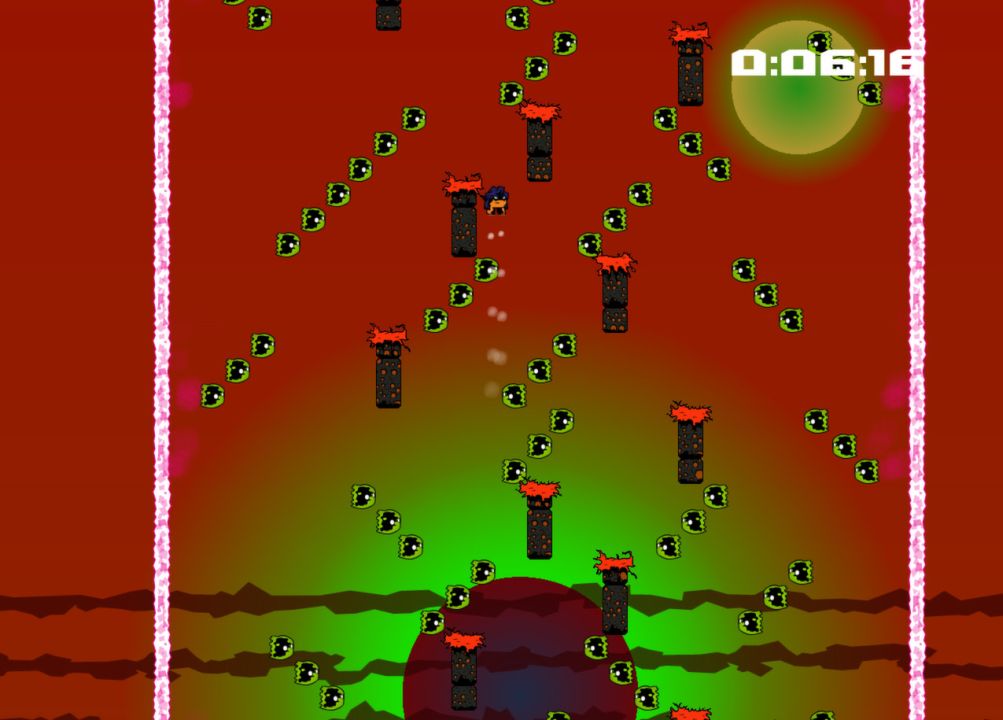
Really though, who could honestly admit to caring? Fenix Rage needs a story about as much as Doom does, and the fact that I’m even bringing it up should tell you that I’m struggling for things to gripe about over here. With that in mind, let’s skip right to the boss battles. Do you remember when you were in primary school and there was that one kid who was really unhealthily into Pokemon? Of course you did; every school had one. They’d sit in the library with a stack of paper and design their own, letting neither their lack of imagination nor their inability to properly handle a pen prevent them from spewing out reams of shapeless uninspired blobs with increasingly difficult to pronounce names. Fenix Rage’s boss battles are where those long-forgotten designs finally surface: a parade of greenish floating things with eyes, mouths and tentacles stapled on seemingly at random. Attack patterns? Well, we have some that fling goo at you, some that chase you, and – wait for it – some that do both. That’s about it, I’m afraid. The final boss stands head-and-shoulders above the rest – possessing both a distinct design and several panic-inducing attacks – but since it’s standing head-and-shoulders above a cesspit full of fetid meat, it still kind of stinks.
I’m also a little taken aback by the Fenix Rage’s approach to a difficulty curve, in the sense that it’s actually pretty reasonable. Normally with this particular brand of platformer it’s customary to load another pallet of limestone on the player’s back every so often, pursuing obscene difficulty at the expense of entertaining gameplay, but if you just accept dying sixty or seventy times per level as a fact of life – which, given the format, it really is – then completing the main campaign is by no means an overwhelmingly difficult feat. Quite an unfortunate sticking point for a game that seems specifically aimed at the kind of person who unleashes a strangled scream of anguish when they spill their morning coffee. Can you really criticise a game for not being deliberately frustrating? I suppose not, especially since I’m obliged to play through as much of it as I can.
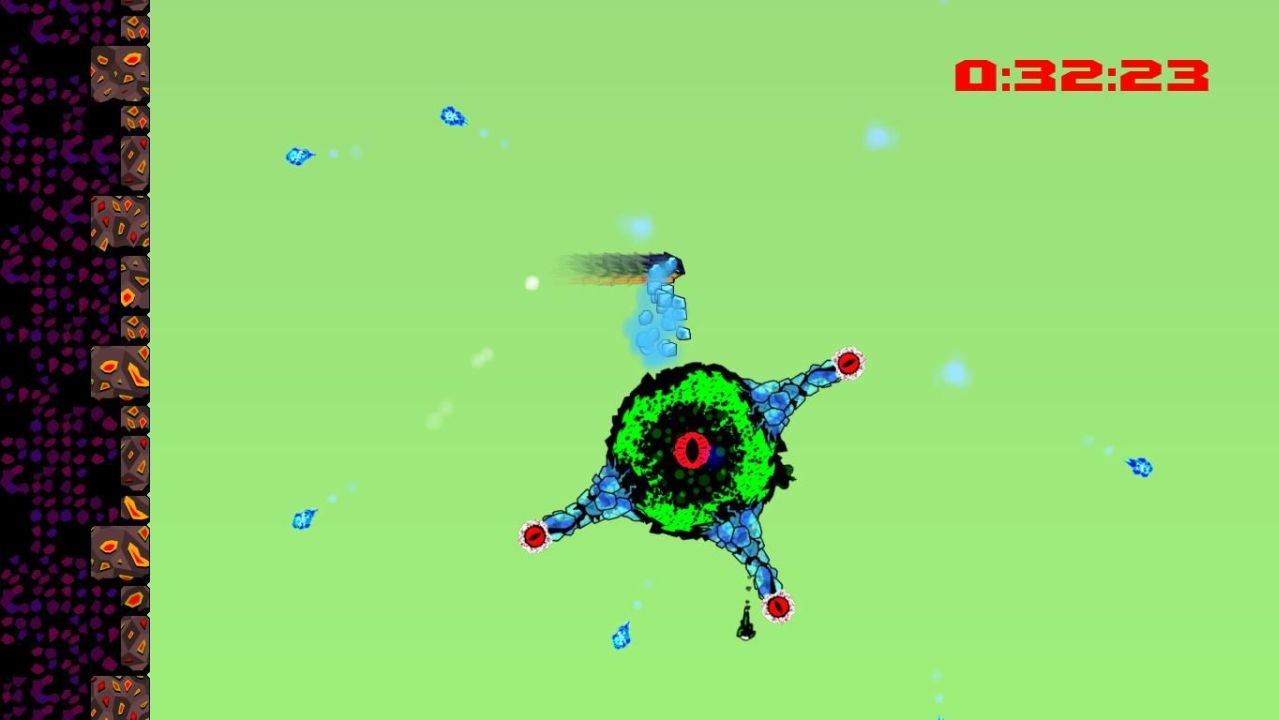
What else? A few housekeeping issues, I suppose. While the game is kind enough to instantly reset you on death, without so much as an annoying animation or loading screen to tear you from the ceaseless flow of your attempts, it’s in such a hurry to do so that it completely forgets to reset all the enemy positions along with you, making consistently building a routine – something that’s practically a staple of masochistic trial-and-error platforming – just a little bit more inconvenient due to needing to manually reset every time via the menu. On the more technical side, the game completely neglects to save the sound settings, so if you’re a massive wuss like me then you immediately have to make a beeline for the options menu to protect your delicate virgin ears every time you launch the game. I’m also one of those picky types who prefers to play platformers with a keyboard, and while the game will indeed allow this – giant ‘GAMEPAD RECOMMENDED’ intro screen notwithstanding – it won’t let you rebind the default keys, a small issue magnified by the fact that X is jump and Z is dash, a configuration that goes against every single synapse in my Spelunky-addicted brain. And if you’re going to recommend we use a gamepad for your elegant, tight, pixel-perfect platformer, why show a picture of the Xbox 360 controller? Have you used the D-pad on one of those things recently? It’s like squashing your thumb into a fat person’s nose and waggling it around.
Alright, alright, I really just wanted an excuse to rag on that D-pad. All facetiousness thrown aside, Fenix Rage is a perfect example of a game that succeeds by keeping its ambitions in check. By no means is it an extraordinary game: it utilises the simplest formula in the book, makes only a few very incremental changes, and even then, makes its fair share of blunders. That’s alright though, you know? Not every game has to strive to be ‘the next big thing’ or ‘the art’; sometimes it’s better just to dump all that aspirational nonsense and concentrate on making a game that’s just fun, responsive, and immaculately polished. That’s what Fenix Rage has done. It lives forever in Super Meat Boy’s shadow, but if you just want more challenging platforming injected straight into your veins then you can’t do much better than this. Contrary to its title, it hasn’t made me enraged at all; it has made me very, very happy.
